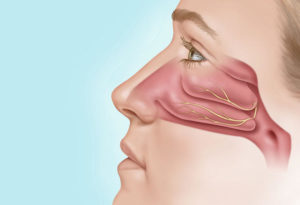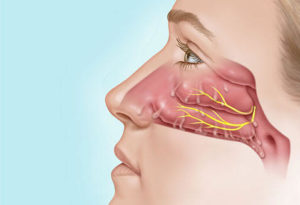Rhinitis (Runny Nose)
Rhinitis also known as runny nose or post-nasal drip is inflammation of the inner lining of the nose and is a very common condition. It can be associated with asthma and chronic sinusitis. Post-nasal drip may lead to chronic sore throat, chronic cough, or throat clearing. Post-nasal drip can be caused by excessive or thick mucus secretions or impairment in the normal clearance of mucus from the nose and throat. Symptoms may include:
- Runny nose (rhinorrhea)
- Nasal itching
- Nasal congestion
- Sneezing
Our office uses ClariFix® cryotherapy to treat Rhinitis. ClariFix® cryotherapy is a treatment that utilizes cold temperatures to stop the source of chronic rhinitis symptoms.
How does it work?
Chronic rhinitis symptoms are caused by out of balance nerves, which may be sending too many signals to your nose, telling it to drip, run and swell more than necessary. Using cryotherapy, the ClariFix® device delivers cold temperatures to these out of balance nerves in the back of the nose, interrupting the signals and reducing your symptoms.
How long until I will see an improvement?
Most patients begin to see improvement between 2 and 6 weeks post-treatment.
What kind of results can I expect?
In a clinical study, patients reported a significant decrease in runny nose and nasal congestion with 4 out of 5 patients reporting longlasting symptom relief.
How long does the treatment take?
You can typically expect to spend about an hour in our office.
What does the treatment feel like?
You may experience slight pressure, a cooling sensation in the nose and/or around the molars, or some discomfort during and/or after the treatment.
What can I expect during the treatment?
Dr. Kerner will start by numbing the nose with anesthetic. The ClariFix® device is then placed in the back of the nose, and the cold therapy is applied.
Is there downtime?
Most patients typically return to normal activity the same day. As with any nasal treatment, you may experience increased sensitivity, congestion, and some discomfort after the treatment.
What are the side effects?
The most common side effects associated with ClariFix® cryotherapy are temporary increased congestion and transient pain or discomfort. Adverse events were those usually associated with post-cryosurgery in nasal passageways and included: pain/discomfort, headache, facial pain, bleeding, dry nose, ear blockage. By day 90, symptoms had either resolved or rated as mild.
Should I continue my current medications after treatment with ClariFix® cryotherapy?
Dr.Kerner will discuss your current medications with you and determine a treatment plan specific to you.
Can I be treated with ClariFix® cryotherapy if I’ve had a previous sinus surgery?
Dr. Kerner will discuss your medical history with you, including previous surgeries and determine a treatment plan specific to you.
Is the ClariFix® cryotherapy device FDA cleared?
Yes, the ClariFix Device is cleared by the FDA. FDA Indication: The ClariFix Device intended to be used as a cryosurgical tool for the destruction of unwanted tissue during surgical procedures, including in adults with chronic rhinitis.
What to Expect
ClariFix Cryotherapy
Before Treatment
- Discuss all medications with us, including anticoagulants and blood thinners
- Discuss your medical history with us, including known blood clotting disorders, allergies to anesthetics or sensitivities to cold
- Take recommended analgesics, if any
- Plan for a 1 hour appointment
During Treatment
- Your nasal cavity is numbed with anesthetic
- The ClariFix device and an endoscope are placed in the back of your nose, where the out-of-balance nerves are located
- Cold therapy is applied for ~30 seconds, 1 to 2 times per side
You may experience any of the following: - Slight pressure
- Cooling sensation in your nose and/or around molars
- Some discomfort, though treatment should not be painful
After Treatment
- You may experience temporary increased congestion and transient pain or discomfort, including headache
- Treatment related discomfort typically resolves within half a day
- Most patients return to normal activity the same day
- Most patients begin to see improvement between 2 and 6 weeks post-treatment
Video Patient Testimonial
Video Animation of procedure






